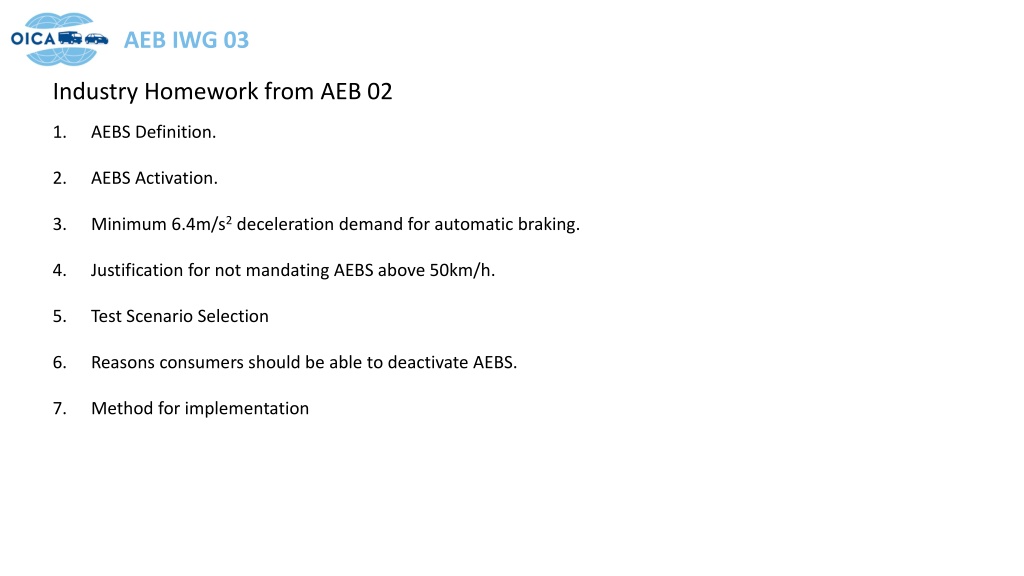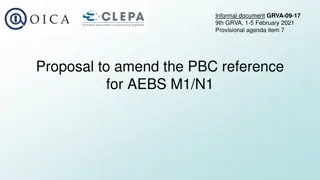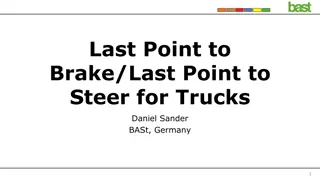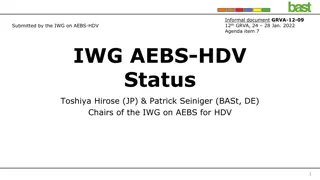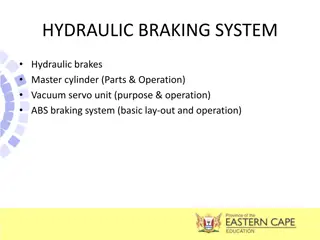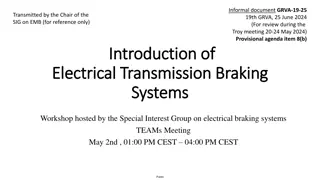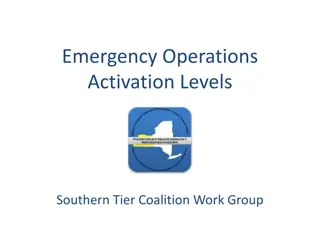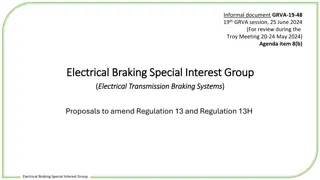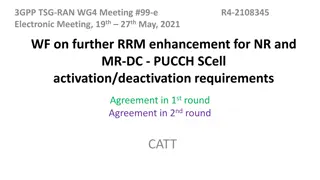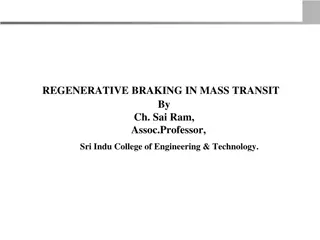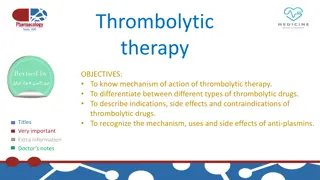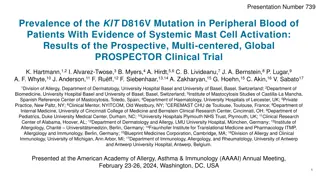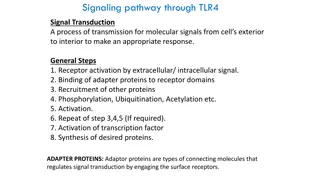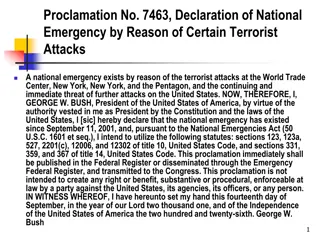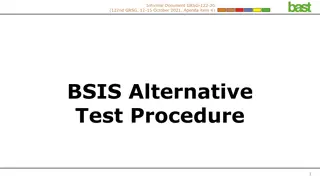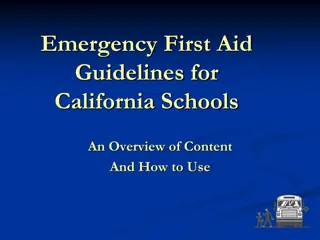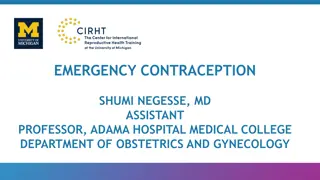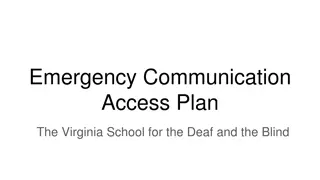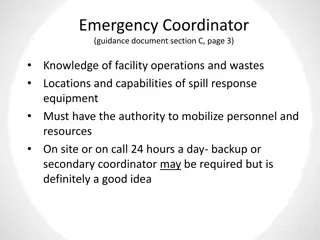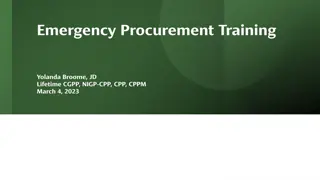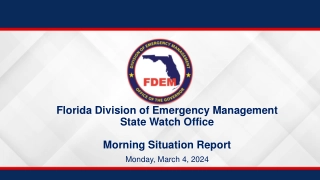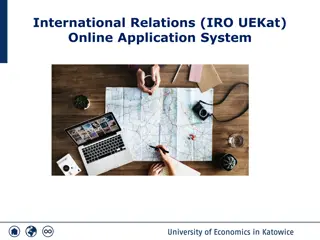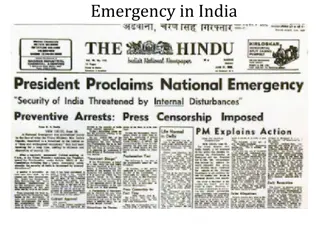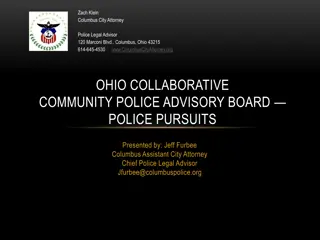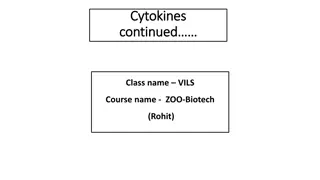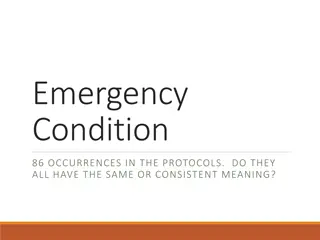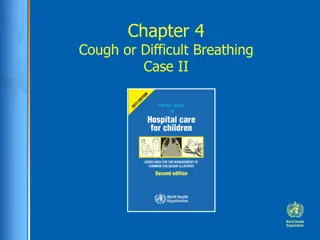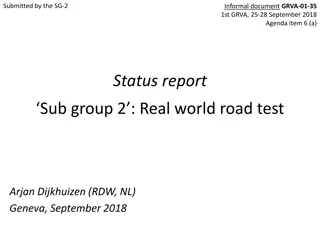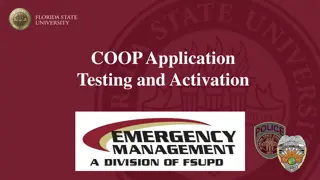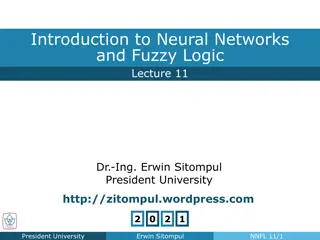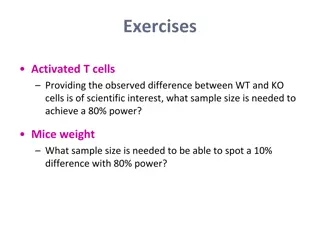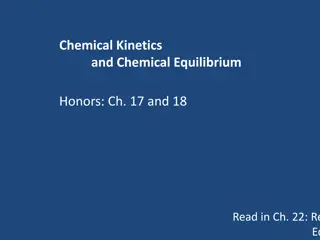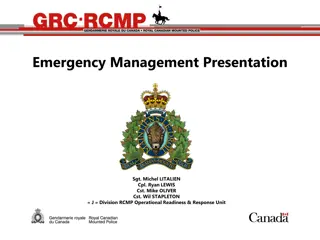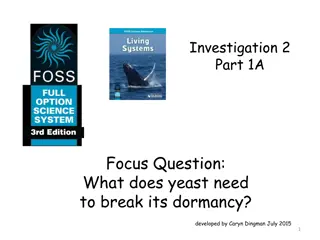Advanced Emergency Braking System (AEBS) Definition and Activation Guidelines
The provided content outlines the definition and activation requirements of the Advanced Emergency Braking System (AEBS). It covers the phases involved, including Collision Warning and Emergency Braking, as well as the speed limitations for activation. The system aims to automatically detect potential collisions, warn the driver, and engage braking to prevent or reduce collision severity. Detailed calculations and strategies for collision avoidance and mitigation are also discussed.
Uploaded on Aug 03, 2024 | 0 Views
Download Presentation

Please find below an Image/Link to download the presentation.
The content on the website is provided AS IS for your information and personal use only. It may not be sold, licensed, or shared on other websites without obtaining consent from the author. Download presentation by click this link. If you encounter any issues during the download, it is possible that the publisher has removed the file from their server.
E N D
Presentation Transcript
AEB IWG 03 Industry Homework from AEB 02 1. AEBS Definition. 2. AEBS Activation. Minimum 6.4m/s2 deceleration demand for automatic braking. 3. 4. Justification for not mandating AEBS above 50km/h. 5. Test Scenario Selection 6. Reasons consumers should be able to deactivate AEBS. 7. Method for implementation
AEB IWG 03 AEBS Definition TTC Advanced Emergency Braking System Collision Warning Phase Emergency Braking Phase Dependant on speed of subject vehicle and target type 2.1. "Advanced Emergency Braking System (AEBS)" means a system which can automatically detect a potential forward collision, provide the driver with a warning and activate the vehicle braking system to decelerate the vehicle with the purpose of avoiding or mitigating the severity of a collision in the event that the driver does not respond to the warning. The Advanced Emergency Braking System shall include a Collision Warning Phase and an Emergency Braking Phase. 2.2. "Emergency Braking Phase" means the phase starting when the AEBS emits an automatic braking demand to the service braking system of the vehicle. 2.3. "Collision Warning Phase" means the phase directly preceding the emergency braking phase, during which the AEBS warns the driver of a potential forward collision.
AEB IWG 03 AEBS Activation The Emergency Braking Phase should be regulated between 10km/h and [50]km/h and should react for vehicle, pedestrian and cyclists. The first stage of implementation should focus of vehicle detection, and the second stage should focus of pedestrian detection. This does not prohibit manufacturers to implement AEBS outside of the speed range or to detect other objects. The AEBS must avoid a collision when the Last Point to Steer (LPS) is before the Last Point to Brake (LPB). LPS is dependant upon: Time to collision, lateral displacement required to avoid a collision and the maximum lateral acceleration of the subject vehicle which highly depends on road conditions (adhesion, slope), load conditions (loaded/unloaded, in some case the COG height, presence of a trailer) and vehicle maintenance (shock absorbers, tyres). LPB is dependent upon: Time to collision and maximum deceleration of the subject vehicle which is also depends on road and vehicle conditions.
AEB IWG 03 AEBS Activation Calculation Strategy: 2 1.8 Time to Collision (Seconds) 1.6 1.4 1.2 1 Evading Braking 0.8 0.6 0.4 0.2 0 0 10 20 30 40 50 60 70 80 Relative Velocity (km/h) Assumptions: Braking Level = 6.4 m/s Lateral Acceleration = 10 m/s Lateral Offset = 2.5m 1. Calculate the TTC dependent on the LPS and LPB.
AEB IWG 03 AEBS Activation Full collision avoidance between 10km/h and [32.6]km/h (LPS = LPB) Calculation Strategy: 2. Collision mitigation between [32.6]km/h (LPS = LPB) and 50km/h 2 Collison avoidance by driver intervention in response to collision warning 1.8 Time to Collision (Seconds) 1.6 1.4 Collision Avoidance through automatic braking 1.2 Collision mitigation by automatic braking 1 Evading Braking 0.8 0.6 0.4 0.2 0 0 10 20 30 40 50 60 70 80 Relative Velocity (km/h) Values need to be agreed during AEBS 03 Assumptions: Braking Level = 6.4 m/s Lateral Acceleration = 10 m/s Lateral Offset = 2.5m 2. The Emergency Braking Phase of the AEBS shall activate no later than the TTC defined by the minimum of LPS and LPB.
AEB IWG 03 AEBS Activation Calculation Strategy: 1. Calculate the TTC dependent on the LPS and LPB. Based on (6.4m/s2 deceleration, 10m/s2 lateral acceleration, 2.5m lateral offset. 2. The minimum performance requirements for the Emergency Braking Phase of the AEBS shall be determined by applying the designated braking performance (ref. calc 1) at the minimum TTC between LPS and LPB. 3. The collision warning phase shall activate before the Emergency braking phase, this is only applicable at speeds higher than [32.6]km/h (LPS = LPB), below this speed the Collision Warning shall occur at the same time as the Emergency braking phase. The proposed calculations are used to determine the fixed performance criteria within the Regulation itself and not a dynamic calculation that vehicles make during real world driving.
AEB IWG 03 AEBS Activation Emergency Braking Phase Performance Requirements 2 1.8 Time to Collision (Seconds) 1.6 Collision Warning at point of EBP Collision Warning based on TTC. 1.4 1.2 1 Evading Braking 0.8 0.6 0.4 0.2 0 0 10 20 30 40 50 60 70 80 Relative Velocity (km/h) 3. The collision warning phase shall activate before the Emergency braking phase, this is only applicable at speeds higher than [32.6]km/h (LPS = LPB), below this speed the Collision Warning shall occur at the same time as the Emergency braking phase.
AEB IWG 03 Minimum [6.4]/[5]m/s2 deceleration demand for automatic braking UNECE Regulation No.13-H/R13 the minimum service brake performance of the vehicle (Type 0 with the engine disconnected) is 6.43 or 5m/s2 for M1 or N1 category vehicles. The regulation for advanced emergency braking shall not specify any minimum deceleration for the vehicle, since this is already regulated in R13-H The minimum deceleration values of the vehicle should not be defined within the regulation, but should be implicit by the performance requirements of the AEBS equipped vehicle . i.e. by defining the conditions when a collision shall be avoided or mitigated. The very same principle applies to the performance of the sensors. The regulation for autonomous emergency braking shall only specify a minimum deceleration demand to the braking system. Depending on the road and load conditions, the vehicle will be able to achieve the demanded deceleration or not. To enable technically neutral requirements for every manufacturer. Higher values will require amendments for UNECE R13-H (& FVMSS135) Allows for compatibility between existing AEB test protocols:
AEB IWG 03 Minimum 6.4m/s2 deceleration for automatic braking. Emergency Braking Phase Performance Requirements compatibility to existing standards 50 Speed reduction (km/h) 40 30 20 10 0 0 10 20 30 40 50 60 Relative speed (km/h) Car-to-car Title System AEB AEB FCW FCW FCW VUT speed 20km/h 40km/h 72km/h 72km/h 72km/h EVT speed 0km/h 0km/h 0km/h 32km/h 72km/h Conditions Pass Criteria 8km/h for both or 16km/h for one IIHS U.S >2.1s TTC >2.0s TTC >2.4s TTC 0.3g at 30m AEB AEB 28.8km/h 72km/h 0km/h 43.2km/h 14.4km/h or 7.2km/h speed reduction FVCMS ISO International Car-to-pedestrian Title PDCMS System AEB VUT speed 30km/h EVT speed Conditions Pass Criteria 20km/h speed reduciton ISO International
AEB IWG 03 Justification for not mandating AEBS above 50km/h absolute velocity. Accident data suggests that the majority of vehicle collisions with other vehicles in urban environments, therefore AEBS for M1/N1 should be regulated for these scenarios where speed differences more than 50km/h are uncommon. At higher speeds the difference in which the last point to steer and last point to brake occur increases linearly, this could lead to a greater possibility of false positives at higher speeds a false positive will have a greater impact on the road user s safety and traffic flow. Greater alignment with voluntary commitment requirements from US manufacturers ease the development of a GTR.
AEB IWG 03 Test Scenario selection NCAP vs Type Approval Performance determination vs minimum safety standard. Designed performance needs to take in account for different conditions in the real world when compared to the test track and designed with safety margin to cover variation in results. NCAP selection of vehicle is based on the most common variants available on the market, type approval vehicle selection is based on the worst case vehicle. Performance based on Ideal conditions e.g. pre prepared brakes (hot.), weather conditions. Level of braking required for type approval should based on UNECE Regulation R13H. (6.4m/s ) for regulatory consistency.
AEB IWG 03 Test Scenario selection EuroNCAP Test Protocol 2018 Title CCRs CCRs CCRm CCRm CCRb CCRb System AEB FCW AEB FCW AEB FCW VUT speed 10-50km/h 30-80km/h 30-80km/h 50-80km/h 50km/h 50km/h EVT speed 0km/h 0km/h 20km/h 20km/h 50km/h 50km/h Impact Postion 50% +/- 50% +/- 50% +/- 50% +/- 50% +/- 50% +/- Conditions Pass Criteria Car to Car 2/6m/s2 at 12/40m 2/6m/s2 at 12/40m CVNA-25 CVNA-75 CVNC CVFA AEB AEB AEB AEB 20-60km/h 20-60km/h 20-60km/h 20-60km/h 5km/h 5km/h 5km/h 8km/h 25% 75% 50% 50% Day & Night Day & Night Day (Obscured EPT) Day NCAP Car to Pedestrian 22 Points CPLA-25 CPLA-50 CPLA-50 AEB AEB FCW 20-60km/h 25-60km/h 50-80km/h 5km/h 5km/h 5km/h 25% 50% 50% Day & night Day & night Day & night CBNA-50 AEB 20-60km/h 15km/h 50% Day (Obscured EBT) Car to Bicycle 22 Points CBLA-50 CBLA-25 AEB FCW 25-60km/h 50-80km/h 15km/h 20km/h 50% 25% Day Day AEBS-02 agreed that the test scenarios and targets should be inspired be EuroNCAP test protocol. The wholes suite of tests defined in the EuroNCAP 2018 protocol is excessive and pre-mature for type approval. Selection should be based on those scenarios that cover the largest percentage of real world accidents.
